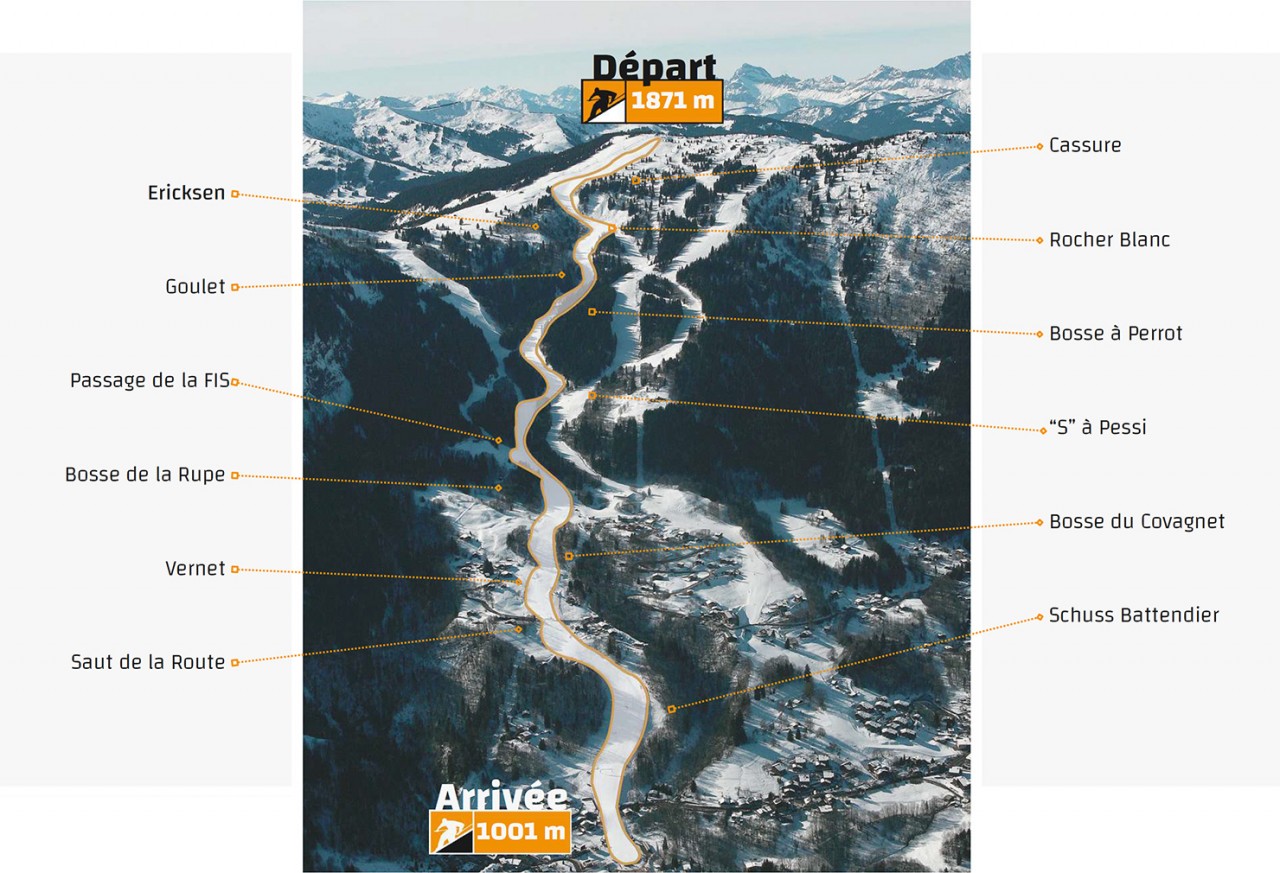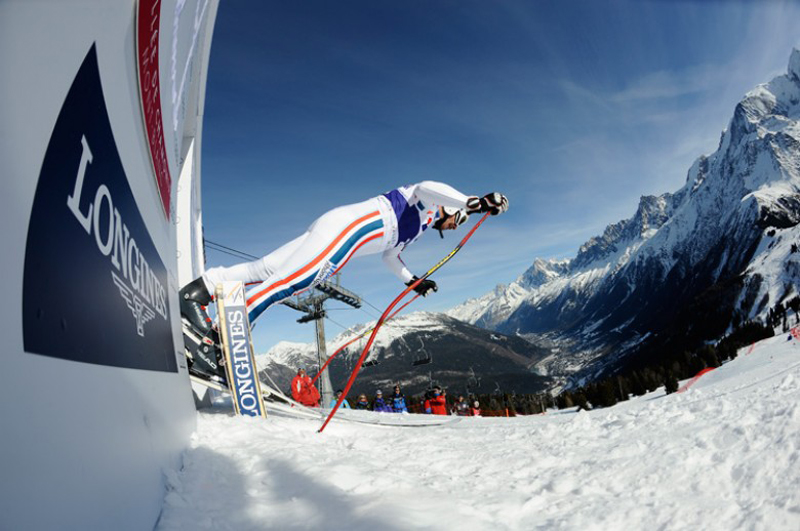
The Piste
The "Verte" piste in Les Houches is 'green' in name only.
This legendary piste in the Mont-Blanc massif is outlined with pine trees. Its environment and orientation towards the sun often offers an ice covered, green tinted slope, from where it gets its name.

THE DOWNHILL PISTE

- Altitude at the start gate: 1871 m
- Altitude at the finish line: 1001 m
- Length : 3343 m
- Vertical drop: 870 m
- Average speed of skiers: 100 km/h
- Top speed of skiers: 140 km/h
This downhill piste is in fact a 3343m long black run with an 870m vertical drop. The best skiers in the world descend it in just two minutes. A series of highly technical sections and jumps, including the Cassure and the Goulet, make this one of the most spectacular runs in the world.
It is the only FIS-approved downhill run on the World Cup Gentlemen's circuit in Haute-Savoie. In France, only the resorts of Courchevel, Val d'Isère and Chamonix - Les Houches have a men's World Cup downhill piste.
The piste has several features: a very dense top section with two 60m jumps interspersed with the Rocher blanc turn, which is one of the most technical on the circuit.
The lower, more undulating section requires real sliding skills before plunging into the always spectacular final schuss.
THE SLALOM PISTE

- Altitude at the start gate: 1169 m
- Altitude at the finish line: 985 m
- Length: 624 m
- Vertical drop: 184 m
- Minimum inclination: 10 %
- Average inclination: 31 %
- Maximum inclination: 45 %
A technical discipline by excellence, the slalom requires a great deal of speed and quickness because the gates are very close together (from 4 to 15 metres for a total of 40 to 75 gates).
A slalom is contested in two heats, and the times from the two heats are added together. Only the skiers who finish in the top 30 in the first run start the second run, and the order is then reversed: the skier who finished 30th in the first run will start the second run, and the skier with the best time in the first run will finish in 30th position. The suspense is always there, as skiers easily make mistakes in this discipline.
The slalom takes place at the bottom of the Verte, a masterly scene for athletes and spectators alike, who can see almost the entire course from the stands. Without being the most technically difficult track on the circuit, it leaves no room for error. With the gaps so small, the slightest mistake can be costly, so tactics and precision are essential for the slalom racers.
Behind the scenes on the piste
THE CHALLENGE 
"It's a real technical challenge because the preparation of the slopes is not the same for downhill and slalom! We have to guarantee optimum preparation for each discipline, i.e. injected snow (icy for the average person) in the slalom and very hard, compact snow throughout the 3km of the downhill.
The slalom and downhill runs have 200m in common, including the finish line! This summer, we've come up with routes that will allow the slalom to cross the downhill line only once. It should be noted that the preparation of the track is not the same: the slalom track is injected with water to make it extremely hard (icy), which is not the case for the downhill.
The objective for speed is to have a uniform track with optimum snow density throughout (jumps, compression, long curves, slopes, etc.). There's no question of surprising a downhill skier at the end of the run after 2 minutes of running on injected snow."
Fred COMTE, director of the Chamonix Sports Club.

THE CHIEF OF THE PISTE'S CHECKLIST
"In September, work began on the downhill run, with all the cabling, moorings, etc. This was followed by the laborious installation of 1.8 km of "A" netting, each measuring 50 m wide and 4 m high. Transported by 4x4, quad and vintage wooden sledge, they were suspended and then tied together. It's a very demanding task for the 3 people working on the site throughout the autumn preparations.
This work is followed by the installation of 15 km of "B" netting, to which are attached tarpaulins 2 m high and 1.5 m wide, stretched to provide optimum cushioning against the fall of skiers. Finally, the 5 km of 'C' netting for spectators to maintain a safety zone in certain areas were installed in the last few days.
To this must be added the installation of the timing lines, the practice areas and cable TV hangers, the spectator stands and the installation of a giant screen on the piste at the break. Finally, and most importantly, the management of the natural and artificial snow from November onwards, guaranteeing the perfect quality and profile for a downhill World Cup!
At the end of October, when the timing lines had been tested and the camera locations defined, work began on preparing the piste. This was the start of a painstaking process that was validated by the famous and dreaded FIS 'snow control' ten days before the competitions... and finished on the morning of the competition.
Essential for slalom events, artificial snow is produced as soon as the first cold spells arrive. It is worked to make it very compact, wetted to increase its density, pushed and aerated before being spread over the track, groomed, injected and then repeated, the idea being to create a mille-feuille of layers (4 to 5 at the best of times), which is then maintained and fine-tuned according to the weather conditions (thawing, snowfall) until the day of the race. In the meantime, the A-nets are laid, the training stadium prepared, the start and finish areas set up and the ground teams briefed. Once the safety conditions and the surface have been approved, the show can begin! "
Tony Angiboust, chief of the piste.





